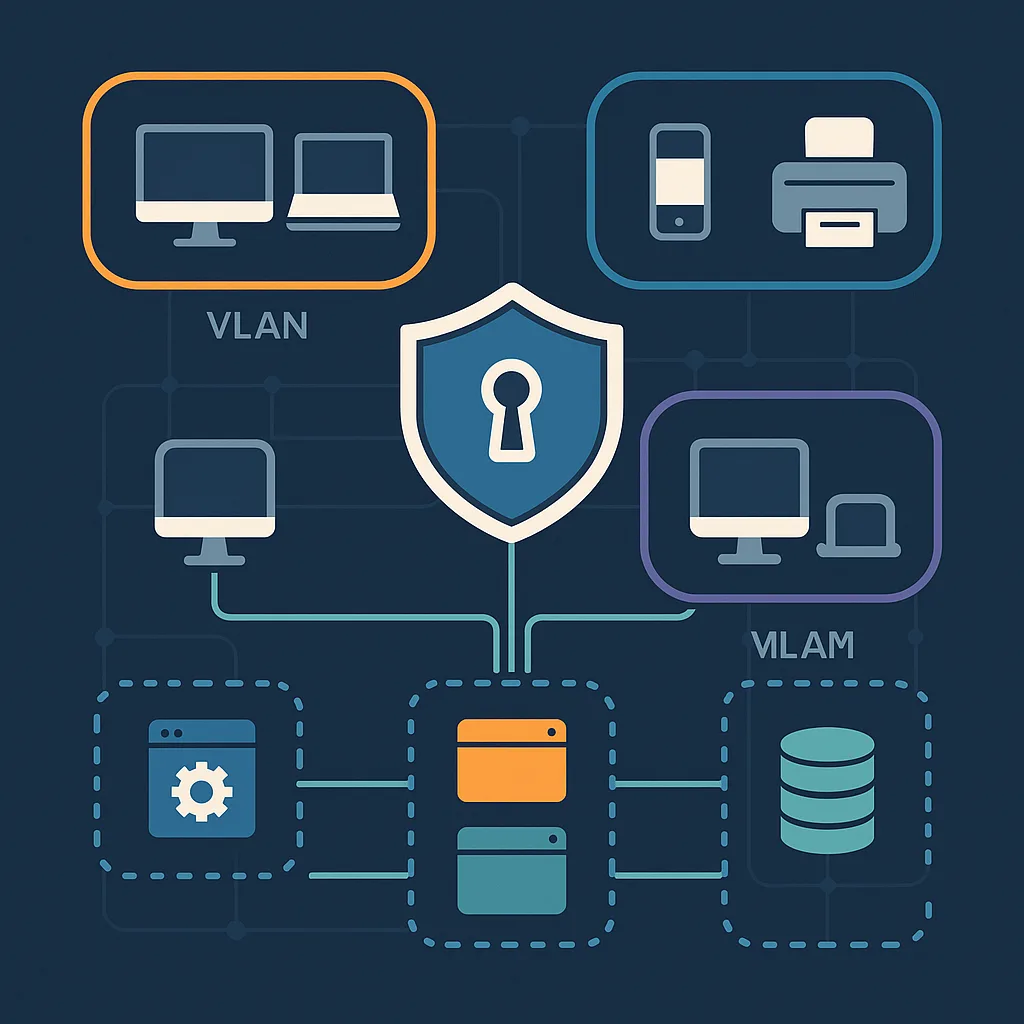In today’s cybersecurity landscape, perimeter defense is no longer enough. Attackers often breach one endpoint and move laterally across flat networks—hitting databases, domain controllers, or cloud sync points. The solution? Strategic network segmentation.
Two powerful techniques—VLANs and microsegmentation—can dramatically improve your internal security posture. This guide explores how to design and implement these segmentation methods efficiently, balancing security with performance and manageability.
Why Segment Your Network?
A segmented network:
- Limits lateral movement in case of compromise
- Enables role-based access to services and data
- Simplifies compliance with standards like ISO 27001 or PCI-DSS
- Reduces blast radius from internal threats or misconfigurations
- Provides visibility and control over traffic flow
Part 1: Segmenting with VLANs (Virtual LANs)
What Are VLANs?
VLANs are logical network segments created at the switch level, allowing devices in separate VLANs to act as if they’re on different physical networks—even if connected to the same hardware.
Benefits of VLANs
- Low-cost logical isolation
- Simplifies broadcast domain management
- Excellent for separating departments, devices, or functions
- Easy to configure with modern managed switches
VLAN Design Best Practices
1. Group by Role or Function
- VLAN 10: Servers
- VLAN 20: Users (HR, Marketing, etc.)
- VLAN 30: VoIP Phones
- VLAN 40: Guest Wi-Fi
- VLAN 50: Management / IT
2. Use a Clear Naming & Numbering Scheme
Keep it consistent across switches, firewalls, and documentation.
3. Isolate Management Interfaces
Never expose switch or firewall management planes to user VLANs.
4. Implement Inter-VLAN Routing via Firewalls
Use Layer 3 switches or firewalls to control what traffic can cross between VLANs.
Example:
User VLAN ↔ (Firewall with ACLs) ↔ Server VLAN
5. Block Unused Ports
Apply default “deny all” policies to unassigned switch ports.
6. Monitor VLAN Traffic
Log and analyze inter-VLAN traffic to detect anomalies or policy violations.
Part 2: Microsegmentation
What Is Microsegmentation?
Microsegmentation is the practice of creating granular, software-defined security policies that control traffic between individual workloads, VMs, containers, or applications, not just between networks.
It enables:
- Application-level control
- East-west traffic filtering
- Policy enforcement in virtualized/cloud environments
- Granular visibility and control
How Microsegmentation Differs from VLANs
| Feature | VLANs | Microsegmentation |
|---|---|---|
| Control Level | Network segment | Per workload/application |
| Enforced by | Switches, routers, firewalls | Hypervisors, software agents, NGFWs |
| Granularity | Medium | Very fine |
| Use Case | Segmenting offices/devices | Securing apps/workloads in cloud or data center |
Microsegmentation Best Practices
1. Start with Traffic Mapping
Use flow data or software agents to map which services talk to each other. This helps you:
- Identify legitimate flows
- Detect unnecessary or risky communication
2. Group Workloads by Role or Sensitivity
Example:
- Web tier
- App tier
- Database tier
- Internal tools
- 3rd-party integrations
3. Apply Zero Trust Policies
Only allow explicitly defined communication flows.
Allow:
App Server → Database Server (TCP 1433)
Deny all else by default
4. Use Tags or Labels for Policy Enforcement
Instead of relying on IP addresses, use dynamic attributes:
- Environment: Prod / Dev / Test
- App: CRM / HR / Finance
- Tier: Frontend / Backend
This works well with container orchestration platforms and cloud firewalls.
5. Test and Audit Rules Regularly
Monitor for blocked legitimate traffic or unused open ports. Adjust policies as environments evolve.
Combining VLANs and Microsegmentation
Use VLANs to group and isolate systems at the network level, and microsegmentation to protect traffic within those groups.
Example:
- VLAN 100: Web Servers
- Microsegmentation: Allow only port 80/443 between web nodes and load balancer
- VLAN 200: App Servers
- Microsegmentation: Allow only app-to-db traffic on port 3306
- VLAN 300: Users
- Microsegmentation: Enforce device posture before allowing outbound connections
Common Mistakes to Avoid
- Relying only on VLANs for segmentation
- Overlapping VLAN numbers across sites
- Using allow-all policies between VLANs
- Forgetting to segment user devices from IoT or printers
- Applying microsegmentation without traffic analysis
Tools You Can Use (Generic Recommendations)
- Network firewalls with VLAN support
- Hypervisor security modules (e.g., ESXi firewalls)
- Cloud-native segmentation tools (NSGs, security groups)
- Network flow analyzers
- Software-defined networking (SDN) platforms
Conclusion
Segmenting your network is no longer optional—it’s essential. VLANs provide a strong foundation for network segmentation, while microsegmentation gives you granular, adaptive control over how your workloads communicate. When combined, they form a powerful, layered defense strategy that limits attacker movement and keeps your infrastructure resilient and compliant.


